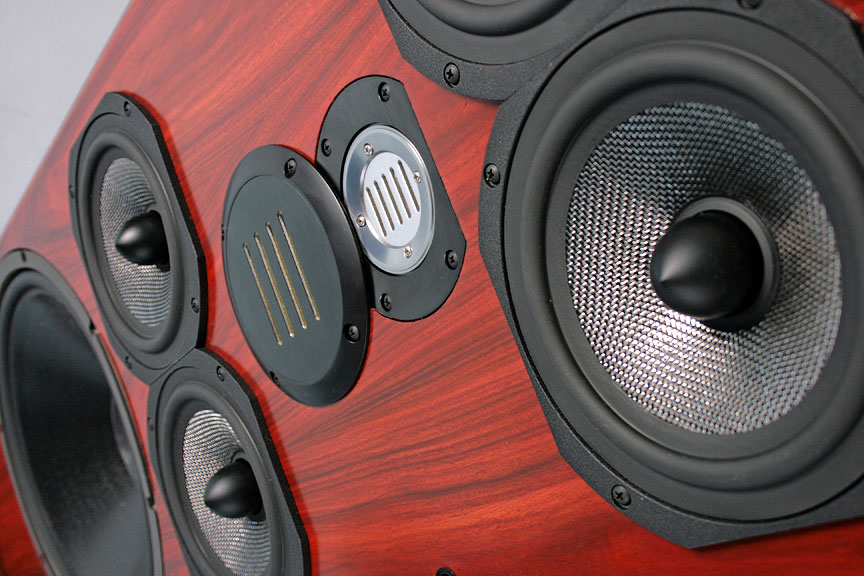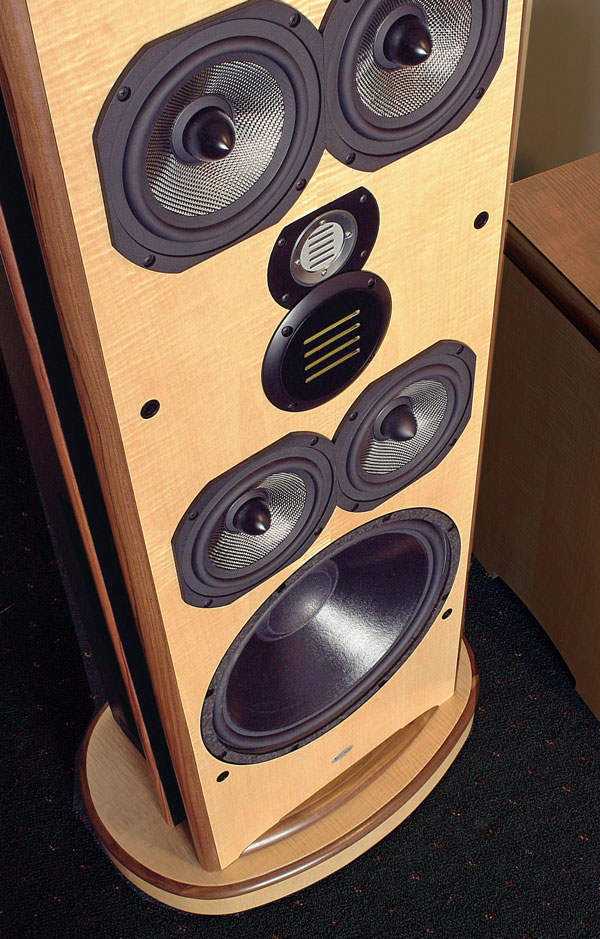A New Standard
After an experience like that of direct comparison between passive and active crossover modes of the DSW realization dawns that this speaker can be made to work supremely well with virtually any set of components. With the ability to craft a personalized crossover there is no condition for which there is not an antidote. Bass shy? Fine, tweak the low-end. Too hot on top? No issue; play down the treble a hair. This is not to say that doing so in any of these instances will result in better sound, but shows you can adjust the sound to suit ad infinitum. Your control is virtually limitless with the DSW’s active system. As a reviewer I can use nearly any amp, any source and know that I can make a respectable rig with it. To be sure shortcomings will be completely exposed, but they will be able to be addressed. If the DSW was merely a passively crossed speaker far, far fewer sets of components would potentially offer acceptable results. As an actively crossed speaker quite literally a component which might not live up to expectations with a passively crossed speaker has a second life, a chance to be heard quite differently.
Imagine, therefore, that you have just paid $5-10K, or more, for amplification and when you hooked it up there wasn’t the bass you were hoping for, or it was too laid back, or sibilant in the treble. Too bad, so sad! You’re stuck because you can’t do a thing to redesign the speakers. If you had the DSW you would be able to spend a few minutes tweaking the filters on the processor, or have Legacy send you an adjustment in a new program to upload to the processor, and you would have sound far closer to what you imagined. How much is that worth? People spend $20K on speakers which if the fit isn’t right they have to reconsider their entire system. Here is a speaker which at minimum performs better than the mass of midget-sized floor standers and not a few of the larger ones. If there’s a glitch in the sound it can be addressed, and when optimized it asserts itself into very exclusive company.
How About A Bit Of Audiophile Heresy?
We listeners are not supposed to touch the recording end of the music, right? We’re supposed to leave that to the pros and be content to assemble the best system to play back what their ears have determined we should hear. Well, what if there’s something they’ve handed you that you don’t think sounds right? What then? I guess we’re supposed to, “Like it or lump it,” as parents used to say.
But wait, with the DSW it’s not cut and dried, as you can do something about music which doesn’t strike your ear as quite right! I enjoy the powerful voice of Steve Perry, former lead of Journey. I was playing “You Better Wait”, a nice power rock song from The very Best of Steve Perry through the DSW when I concluded, “I don’t like this!” It wasn’t that the experience itself was poor, just one niggling aspect of the song – the recording was insipid in the bass. Then it occurred, “Wait, I have the means to do something about it!” So I opened the processor and went to the main window where all the filters are shown in numeric form. I highlighted the numeric gain setting for the left bass driver set. A new window opened up with sliders for fine-tuning the gain for all channels. I simply double clicked on the left bass slider, slid it up from -6.0 dB to -4.5 dB (decreasing the negative setting increases gain), did the same with the right channel and – Voila! Instant stadium power, major concert feel! Now I could listen to the disc with satisfaction that the power rock was not powder-puff rock.
As I’ve listened more to the DSW in active mode, as well as hybrid active/passive mode, I’ve kept the software for the processor open on the laptop. If I hear something that seems really poor in a recording I become an armchair sound engineer and make it right to my ears. I am fully aware that this crosses some invisible line in the sand, which audiophiles normally do not trespass. How in the world is one to know what the real piece of music sounds like if one is manipulating the signal? The truth is that the engineers, designers and system assembly experts are all, to a degree, manipulating the real sound to varying degrees. They use their ears to impress upon us what they think is good, or “real” sounding. Bill sets the filters for the DSW, and he does a primo job, as I find very little to futz with, but the capacity is there to let your ears decide the final settings. Isn’t that what we say in audio, that your ears need to be satisfied with the sound of the music? If it’s not, you can do a little Modding to the signal instead of the gear. Remember, if you screw up you can recall the preset program in seconds and all is forgiven.
Perhaps you think Elton John’s rendition of “Don’t Let the Sun Go Down On Me” from his live VH-1 recording is not quite nasal enough. Let’s say you just love hearing the nasal cavity in singer’s voices and you want more schnoz in the song. Simply go to the filter/graph of the tweeter response in the 10k Hz plus region and double click on the number 2 on the frequency curve, latching onto it. Pull it up a couple decibels and Elton’s nose will be more involved in the performance. His voice will sound a tad raspier and the piano will have a bit more bite. I tried it and while it was interesting I prefer Bill’s setting. But you may like your own better.
Oh, no! In this compilation immediately following on the heels of Elton is Neil Young’s “Like A Hurricane”! Retreat! Down with the treble, and quickly! He’s one artist that definitely does not need a treble enhancement! Of course you may think otherwise. The software makes you feel powerfully in control of the system, as well as engenders respect for the recording side of the industry.
The DSW not only allows for fine tuning of systems through altering the speaker system, it can also fine tune recordings at the back end to suit! That media you’ve been frustrated with can be doctored to please you. That artist you would like to listen to, except for that problem you hate with the recording, can now be redone to compensate. How’s that for true power with audiophile speakers?
Dream Speaker
The DSW is a music lover’s dream, its sound quality is an audiophile’s dream, and its flexibility is a tweaker’s dream. It’s the kind of speaker that lends itself to a plethora of configurations and endless explorations of top-quality sound, if so desired. If you find yourself getting bored with speakers, longing for a change on a regular basis, the DSW is your panacea. If you understand how alternating amps and crossovers recast the performance of a speaker, then you can appreciate the power of these alternative modes of operation. If you have had the experience of making a change to another part of your system and were not thrilled, with the DSW you have the power to adapt the speaker to improve the result. With the DSW you’re never stuck. You don’t have to go out and search for a new speaker; reconfigure its mode or processor and you’ve got your new speaker!
I recently saw a YouTube™ video about a man who climbs free solo wearing a parachute. If he slips and falls he has a bailout plan. His point, “I love making the worst situation turn into the best situation.” Audiophiles sometimes bail out of speakers because they can’t make them sound as desired, or they give up the search because they can’t make any speaker sound how they want. What if the speaker came with a “parachute plan”? The DSW does; you can make it adapt to nearly any system and configure it to tickle any ear. Don’t get me wrong, the DSW is never poor, and often superlative. It can take a difficult setup and turn it into a good situation; it can take a good situation and turn it into a celebration. That is the unique advantage of the DSW as a true outlier.
Active Crossover Wins
There is an inevitable curiosity with a speaker like the DSW as to which mode is superior. The answer is quite clear for Bill and me – active crossover mode, no contest. While there may be one or two instances of drawbacks, like the high gain of the Ayon CD-5 player direct through the processor causing unacceptable noise on the signal (this was corrected by inserting a preamp like the VAC Signature MkII), most configurations were problem-free. The CD-5 holistically sounded better with the active mode.
There is a slight background noise associated with the high sensitivity of the DSW and the use of an active crossover. However, I have heard similar noise in highly efficient passively crossed speakers with particular pairings of amplifiers. I do not consider it a significant irritant, especially in light of the fact that I could not get the DSW to approach similar sound quality in passive crossover mode. I consider myself a fanatic in terms of seeking absolutes in performance, including absolute silence during null passages. However, if acceptance of a wee bit of noise is the price to pay for a massive increase in overall sound quality, I’ll make that trade any day of the week.
Prior to acquiring the DSW I would have held the opinion that proponents of actively crossed speakers were a bit sensational, a little overbearing. Online threads occur with numbing regularity about putting an active crossover on a panel speaker. Those bold enough to mod them gush about the improvement. My experience with the DSW in general confirms that active is better. Pros have been doing active x-overs for ages. Aside from fear of their complexity and the misnomer that passive crossovers are just as good, the pros are right. The passively crossed mode was outclassed handily.
In my listening habitus I desire to reach the bottom line on a product efficiently. The active mode allowed me to do that best, and I don’t see that changing. In the DSW I was able to conduct the test with a phenomenal speaker, and found that quality, driver configuration and active crossover makes it an outlier. I won’t say that the active mode will, in all systems under all conditions, be preferable. There was that smooth, subtle romantic element that appealed to me with the passive crossover. Just as I switch between dynamic and panel speakers, I can see myself occasionally switching modes with the DSW just because I can. But something tells me that the time spent in passive crossover mode will be brief and the extra cabling for the tri-amped active mode will not sit idle for long.
That, in the end is what my dangerous idea and Bill’s execution of the DSW is about, hearing music like virtually no other transducer can produce it, regardless of cost. It wasn’t made only for me, but is available as a Whisper option from Legacy Audio. It’s within reach for many committed, patient and quality-oriented audiophiles, which means you also can hear your music like virtually no other transducer can produce it. By virtue of its attributes, anyone who owns top quality components and uses it in the active crossover mode becomes an audiophile outlier, with all the privileges that entails for the listening experience. To get started you only need to ask, “What if…?”
- (Page 1 of 1)


